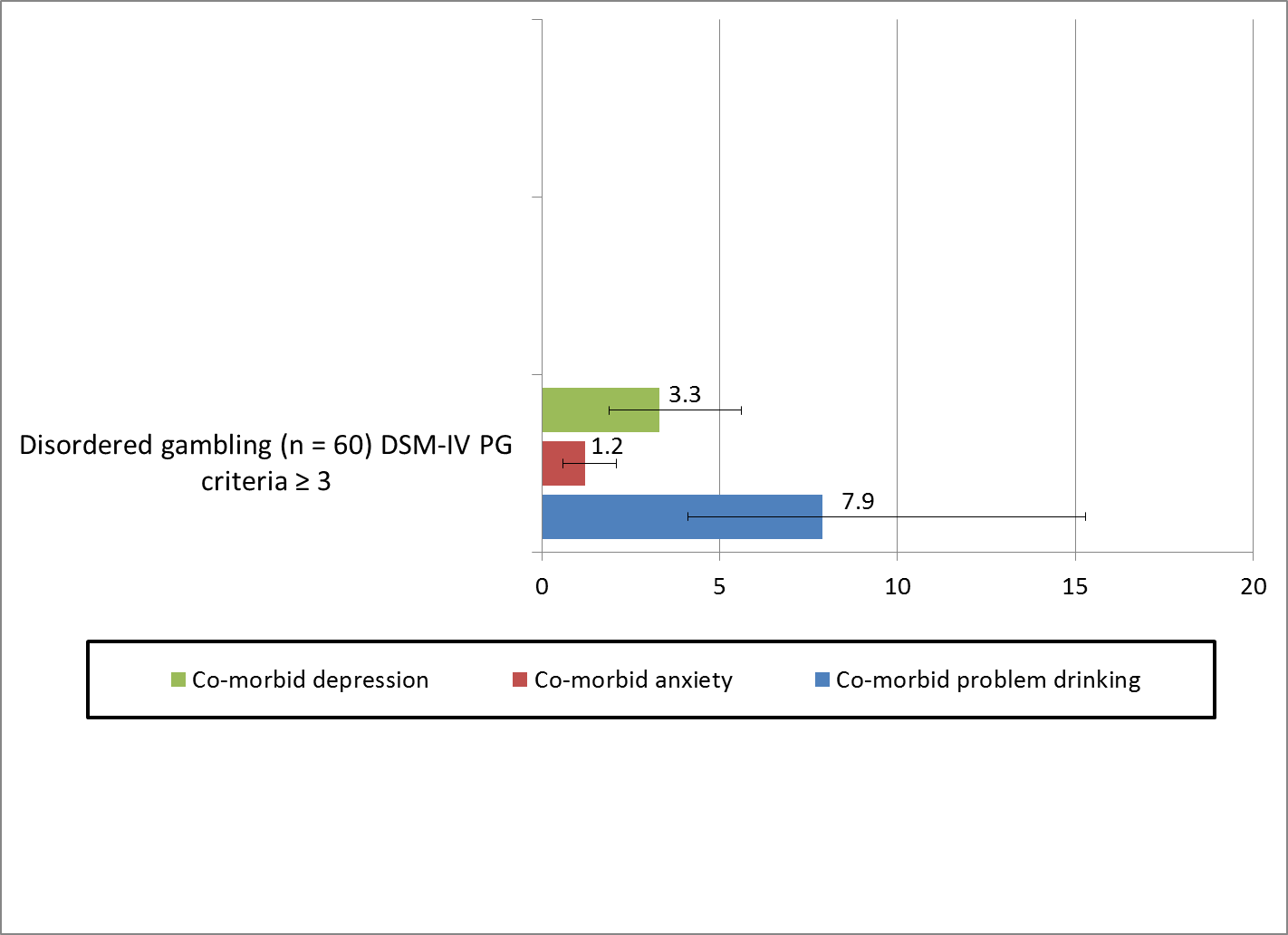The WAGER, Vol. 18(9) – Strong odds: The comorbidity of gambling disorders with alcohol and depression among college students
Among the general population, those with gambling disorders often suffer from a variety of co-occurring disorders (e.g., anxiety, depression, substance abuse; Kessler et al., 2008; Lorains, Cowlishaw, & Thomas, 2011). College students also are at increased risk for gambling disorders, drinking problems, anxiety, and mood disorders (American College Health Association, 2013; Hingson, Zha, & Weitzman, 2009; Shaffer & Hall, 2001), but few studies have studied how risk for experiencing co-occurring conditions varies by disorder. This week’s WAGER reviews a study that examined gambling disorders and co-occurring psychiatric disorders among college students (Martin, Usdan, Cremeens, & Vail-Smith, 2013).
Methods
- During the spring of 2011, researchers surveyed a convenience sample of 2,254 undergraduate students enrolled in an introductory health course at a large southeastern university. They received completed surveys from 1,430 students (RR = 63.4%).
- Students had 7 days to complete an online survey (i.e., HLTH 1000 survey).
- The HLTH 1000 survey included demographic measures and measures designed to assess gambling, alcohol use, anxiety, and mood disorders.[1]
Results
- 4.2% of students reported 3 or more symptoms of pathological gambling
- 38.0% of students were at risk for problem drinking
- 17.9% of students met criteria for depression
- Students who experienced symptoms of pathological gambling were more likely than others to experience problem drinking (81.7% versus 36.1%) and depression (40% versus 16.9%)
- As Figure 1 shows, students who experienced gambling-related symptoms had 8 times higher odds than others of reporting problem drinking and 3 times higher odds of reporting depression.

Figure. Co-morbidity among participants experiencing gambling disorder (modified from Martin, Usdan, Cremeens, & Vail-Smith, 2013). Click image to enlarge.
Limitations
- The cross-sectional design of the study limits the ability to conclude that certain disorders caused other disorders.
- The study relies on self-report about each student’s mental health status. They might respond in a socially desirable way instead of answering truthfully, a pattern which would lower the prevalence rate of each disorder.
- Students also might have trouble accurately recalling their behavior during the past year.
- The study’s findings have limited generalizability to other students outside of health classes, other types of colleges and other geographic regions.
Conclusions
This study supports previous work with the general population that those dealing with a gambling disorder often have co-occurring disorders. However, college students appear to have a much more serious comorbidity between gambling disorders and problem drinking and depression, as compared to the general population. We know from other research that people experiencing gambling problems do not typically seek treatment for gambling problems (Kessler & Merikangas, 2004), but often do for other co-occurring disorders (Kessler et al., 2008). Mental health practitioners working with college students should be aware of this and add a gambling disorder screen to their professional toolkit, and should explore other mental health issues among students who have gambling problems.
-John Kleschinsky
What do you think? Please use the comment link below to provide feedback on this article.
References
American College Health Association. (2013). American College Health Association – National College Health Assessment II: Reference Group Data Report Fall 2012.
American Psychiatric Association. (2000). DSM IV-TR: Diagnostic and statistical manual of mental disorders–Text revision (Fourth ed.). Washington, D.C.: American Psychiatric Association.
Hingson, R. W., Zha, W., & Weitzman, E. R. (2009). Magnitude of and trends in alcohol-related mortality and morbidity among U.S. college students ages 18-24, 1998-2005. J Stud Alcohol Drugs Suppl(16), 12-20.
Kessler, Ronald C., Hwang, I., LaBrie, Richard A., Petukhova, M., Sampson, N. A., Winters, K. C., & Shaffer, Howard J. (2008). DSM-IV pathological gambling in the National Comorbidity Survey Replication. Psychological Medicine 38(9), 1351-1360.
Kessler, Ronald C., & Merikangas, Kathleen R. (2004). The National Comorbidity Survey Replication (NCS-R): Background and aims. International Journal of Methods in Psychiatric Research, 13(2), 60-68.
Kroenke, K., Spitzer, R. L., & Williams, J. B. (2001). The PHQ-9: validity of a brief depression severity measure. J Gen Intern Med, 16(9), 606-613.
Lorains, F. K., Cowlishaw, S., & Thomas, S. A. (2011). Prevalence of comorbid disorders in problem and pathological gambling: systematic review and meta-analysis of population surveys. Addiction, 106(3), 490-498. doi: 10.1111/j.1360-0443.2010.03300.x
Martin, R. J., Usdan, S., Cremeens, J., & Vail-Smith, K. (2013). Disordered gambling and co-morbidity of psychiatric disorders among college students: An examination of problem drinking, anxiety and depression. J Gambl Stud. doi: 10.1007/s10899-013-9367-8
Saunders, J. B., Aasland, O. G., Babor, T. F., de la Fuente, J. R., & Grant, M. (1993). Development of the Alcohol Use Disorders Identification Test (AUDIT): WHO Collaborative Project on Early Detection of Persons with Harmful Alcohol Consumption–II. Addiction, 88(6), 791-804.
Shaffer, Howard J., & Hall, Matthew N. (2001). Updating and refining prevalence estimates of disordered gambling behaviour in the United States and Canada. Canadian Journal of Public Health, 92(3), 168-172.
Spitzer, R. L., Kroenke, K., Williams, J. B., & Lowe, B. (2006). A brief measure for assessing generalized anxiety disorder: the GAD-7. Arch Intern Med, 166(10), 1092-1097. doi: 10.1001/archinte.166.10.1092
[1] Measures included the DSM-IV pathological gambling screen (American Psychiatric Association, 2000), the Alcohol Use Disorders Identification Test (i.e., AUDIT; Saunders, Aasland, Babor, de la Fuente, & Grant, 1993), the Generalized Anxiety Disorder 7 screen (i.e., GAD-7; Spitzer, Kroenke, Williams, & Lowe, 2006), and the Personal Health Questionnaire Depression scale (i.e., PHQ-9; Kroenke, Spitzer, & Williams, 2001).
